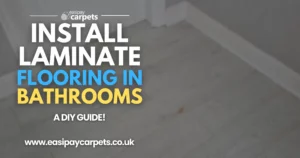

DIY Laminate Flooring: How to Cut Planks Like a Pro
The Best Ways to Cut Laminate Flooring When DIY Installing
Installing laminate flooring is a fantastic way to upgrade your home’s appearance, and with a little preparation, it’s a project you can tackle yourself. One of the most critical aspects of DIY laminate installation is cutting the planks accurately to ensure a perfect fit. Whether you’re trimming pieces to fit around doorways or along walls, using the right tools and techniques is key to achieving a professional finish.
This guide will walk you through the best ways to cut laminate flooring, the tools you’ll need, and some expert tips for clean, precise results.
Tools for Cutting Laminate Flooring
To cut laminate flooring effectively, it’s important to choose the right tool for your specific needs. Here are the most commonly used tools:
Circular Saw
- Best For: Straight cuts on large pieces of laminate.
- Advantages: Fast and efficient, especially for long cuts.
- Tips: Use a fine-tooth blade designed for laminate to reduce chipping. Always cut with the decorative side facing up.
Jigsaw
- Best For: Intricate cuts, such as curves or around pipes and corners.
- Advantages: Highly versatile and perfect for detailed work.
- Tips: Use a blade with fine teeth to minimise splintering. Cut with the decorative side facing down for a smoother finish.
Table Saw
- Best For: Rip cuts (lengthwise cuts along the plank).
- Advantages: Provides precise, straight cuts for long planks.
- Tips: Ensure the saw is set up with a sharp, laminate-specific blade.
Hand Saw
- Best For: Quick, small cuts or when power tools aren’t available.
- Advantages: Affordable and simple to use.
- Tips: Use a fine-tooth hand saw for a cleaner cut and work slowly to avoid chipping.
Laminate Cutter
- Best For: Straight cuts with no power tools required.
- Advantages: Quiet, dust-free, and designed specifically for laminate.
- Tips: Apply steady pressure to ensure a clean cut.
Utility Knife
- Best For: Scoring and snapping thin pieces or vinyl-laminate hybrids.
- Advantages: Lightweight and ideal for trimming edges.
- Tips: Score the laminate multiple times before snapping it to avoid uneven edges.
How to Cut Laminate Flooring
Step 1: Measure Accurately
- Use a tape measure to mark the plank with precise dimensions.
- Double-check your measurements to avoid waste and ensure a perfect fit.
Step 2: Mark the Cut Line
- Use a pencil or marker to draw the cut line.
- For straight cuts, use a T-square or straight edge to keep the line accurate.
Step 3: Secure the Plank
- Place the plank on a stable work surface. Use clamps to hold it in place if necessary.
- Ensure the plank is fully supported to prevent splitting during cutting.
Step 4: Make the Cut
- For circular saws, table saws, and jigsaws, let the tool reach full speed before cutting to avoid jagged edges.
- For hand saws or laminate cutters, use steady, even pressure to achieve a clean cut.
Step 5: Smooth the Edges
- After cutting, use sandpaper or a file to smooth rough edges for a professional finish.
Types of Cuts for Laminate Flooring
Straight Cuts
- Use a circular saw, table saw, or laminate cutter for precise, straight edges.
- Ideal for cutting planks to fit along walls or doorways.
Rip Cuts
- A table saw is the best tool for lengthwise cuts.
- Rip cuts are essential when fitting the last row of planks.
Notches and Curves
- Use a jigsaw to create custom cuts around pipes, door frames, or other irregular shapes.
- Mark the shape carefully and cut slowly to maintain accuracy.
Angled Cuts
- For cuts at specific angles, use a mitre saw or adjust the angle on a jigsaw.
- Angled cuts are often needed for corners or when transitioning between rooms.
Tips for Cutting Laminate Flooring Like an Expert
- Use the Right Blade: A fine-tooth blade reduces chipping and ensures smooth cuts.
- Cut in the Right Direction: For circular saws and table saws, cut with the decorative side up. For jigsaws, cut with the decorative side down.
- Minimise Waste: Plan your cuts carefully to make the most of each plank.
- Work in a Dust-Free Environment: Cutting laminate creates dust, so work in a well-ventilated area or use a dust collection system.
- Practice First: Test your tool and technique on a scrap piece before cutting actual planks.
Common Mistakes to Avoid
- Rushing the Cut: Hurrying can lead to jagged edges or uneven cuts. Take your time for a professional finish.
- Skipping Safety Gear: Always wear safety goggles and a dust mask when cutting laminate flooring.
- Using the Wrong Blade: Blades not designed for laminate can cause chipping or splintering.
Conclusion
Cutting laminate flooring may seem daunting at first, but with the right tools and techniques, it’s a straightforward process. Whether you’re using a circular saw for straight cuts or a jigsaw for intricate shapes, following these expert tips will help you achieve clean, precise results. By taking your time, planning your cuts, and avoiding common mistakes, you’ll ensure a flawless laminate flooring installation that looks professional and lasts for years.
Easipay Carpets can help you get brand new flooring without the high up-front cost – by simply letting you spread the cost of the flooring over time instead. There’s no interest on our plans so you aren’t spending a penny more than you would buying it outright and we include underlay, door trims, carpet grippers and laminate beading for free. Prices start from just £10 per week!
It starts with a free home appointment and quote, to get booked in at a time that suits you, tap the “Get Started” button below and fill out the contact form!
Still Got Questions? Here's 10 FAQs!
A circular saw is best for straight cuts, while a jigsaw is ideal for detailed shapes and curves.
Yes, a laminate cutter or fine-tooth hand saw can be used for straight cuts.
Chipping occurs when the wrong blade is used or the cut isn’t made with the decorative side facing the correct direction.
Yes, use a fine-tooth blade designed specifically for laminate to reduce chipping.
Use a jigsaw for precise cuts and take measurements carefully.
It’s possible, but cutting laminate creates dust, so it’s better to work in a well-ventilated area or outdoors.
Use a table saw for straight, lengthwise cuts.
A utility knife can be used to score and snap thinner pieces.
Yes, sanding rough edges gives a clean, professional look and prevents splintering.
Yes, leftover pieces can often be used for smaller sections or future repairs.




